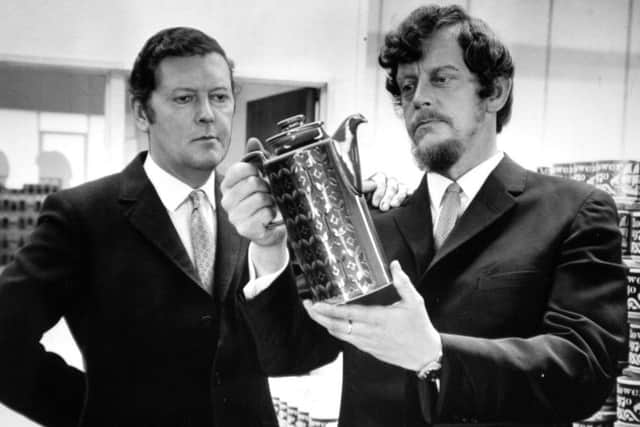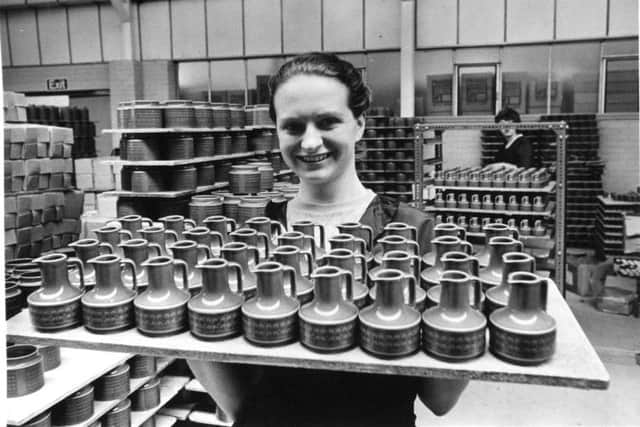Meet the woman bringing Hornsea’s unlikely pottery tradition back to life
What are the great names of British porcelain and pottery-making? Well, there’s Wedgwood. And Spode. And South Yorkshire’s Rockingham. Doulton, of course, and the ubiquitous Moorcroft. But what about Hornsea? Yes, gallant little Hornsea Pottery which, for a brief few years, was among the leaders in the field for eye-catching designs.
But it wasn’t the product of a one-man band. For Hornsea Pottery, at one point, employed more 700 people in the trade. Not bad for a town with a population of just over 8,000.
Advertisement
Hide AdAdvertisement
Hide Ad“Everyone in Hornsea knew someone else who was involved with the pottery,” says Adele Howitt, the Leeds-born artist, ceramicist and expert on the art of pottery. “Whole families worked there. It was a bit like all those towns in the 19th and early 20th centuries that almost entirely relied on a single industry – whether it was making biscuits, or shoes, or ships.”


The business did indeed start small. “The fact that it began at all is a miracle in itself”, laughs Adele, “because you immediately associate pottery with clay. And clay then equalled Stoke on Trent, at the heart of what became known as The Potteries. There isn’t much clay around Hornsea, and Hornsea is a heck of a long way from Stoke on Trent!”
Incredibly, Hornsea Pottery started off, (back in 1949), with plaster of Paris. Two brothers, Colin and Desmond Rawson had been to the Batley School of Art, and returned to their hometown to make plaster souvenir models for the tourist trade – back then, in the years just after the war, few people had holidays abroad, and Hornsea enjoyed something of a holidaymaking boom. The brothers worked from home, in the back scullery of 4, Victoria Avenue. The first funding for their enterprise came from a friend, and local businessman, Philip Clappison.
Advertisement
Hide AdAdvertisement
Hide AdNo-one knows who it was that made the decision to turn production from plaster to proper pottery. “This was a time when there was little attention to archiving anything,” says Adele.


However, it seems that after only a few months the brothers had purchased a small kiln and products were selling well. So well, in fact, that they took on their first employee, and moved from their home into premises in The Old Hall, in Hornsea’s marketplace. Philip Clappison’s son, John, had been to Hull College of Art and was a young man with talent, and the founding brothers took him on board. His first designs formed the stylish and highly contemporary Elegance range, which started to make the firm’s name.
Elegance is still much-loved – and highly collectable – today. “People were clearly tired of the drab days of the war and the post-war years”, says Adele, “and they wanted something different in their homes. Something to brighten life up a bit”. Having found a significant niche market for the time – affordable pieces for the home – the Pottery was thriving. So in 1954 it moved again, and this time to the site of the old Hornsea Brick and Tile works. They took on designers who were part of the colourful and innovative spirit of the day.
“Many people will remember the names of the designs”, says Adele, who trained at Chelsea College of Art and had a successful London-based business of her own before moving back to Hull, and then (ten years ago) to Hornsea. She is the owner and director of Studio Eleven in Hull, and, among many other posts, is director of the Contemporary Visual Arts Network (Yorkshire).


Advertisement
Hide AdAdvertisement
Hide AdShe knowledgeably reels off products in the Heirloom, Saffron, Bronte (a big winner) Contrast and Concept ranges. These were just a part of the prodigious output, which were sold at places such as Harrods and Selfridges. By the early 1970s, the site turned out a staggering three million pieces every year, and employed 250 people. But then, instead of sticking to what they did best, the management decided to diversify. And this, perhaps, was the start of the decline.
They added factory tours and also diversified into production across the Pennines, in Lancaster – but this lasted only a dozen years. “In their heyday,” says Adele, “the company exported all over the world. They were fully approved by The Design Centre in London, and some of the products were so popular and desirable that many department stores couldn’t keep up with the demand, and they stocked Hornsea Pottery on a quota basis.”
At its peak in 1981, Hornsea Pottery had around 700 employees. But the Lancaster expansion put a strain on the finances and the firm’s bankers were called in to suggest a way forward. Changes were made at the top. One of the cruellest blows came when John Clappison was made redundant on New Year’s Eve in 1984. His designs for Strada trinket boxes and his People series were getting big sales, but, to the money men, that didn’t signify anything.
Perhaps John got the last laugh when he was immediately offered a new job with Royal Doulton.


Advertisement
Hide AdAdvertisement
Hide AdThere was growing competition from outside the UK at this point, with Japanese tableware flooding the market, and cheaper tableware arriving from Eastern Europe and beyond. By the year 2000, the end was nigh, and the bank sent in the receivers. The town was hit hard. A spin-off business, Park Rose Pottery, rose from the ashes but it only had a brief life, shutting its doors seven years ago, not long after Adele had moved to Hornsea.
However, the heritage still exists. “Let’s not forget that the Hornsea Pottery, as they went along, also developed incredible new technology. They really did move with the times. I wondered if we could in some way revive the pottery and make people aware of it again – to take it back on to the streets.” And this has now happened. Adele took her ideas to the Hornsea Area Business Partnership, and together they have created colourful public displays throughout the community. There is one design (the always popular Murmuration) displayed as an eye-catching tree sculpture on a mini-roundabout.
Another one is based on the Murmaric (a combination of mural and ceramic) wall plaques of the 1970s. The stripe of the Elegance series is now transformed into outdoor seating, and there is much more besides. Adele spent more than two years exploring the “back catalogue” of the Pottery to see which of its products could be adapted into architectural and free-standing forms.
It has now become one of the best public art trails in the country. You can now navigate your way around and along The Bronte Cup and Saucer (it is claimed that Charlotte herself came to Hornsea to “take the waters”) The Contrast Teapot and the heirloom Coffee Pot.
Advertisement
Hide AdAdvertisement
Hide AdAdele has her own impressive personal collection at home and she points out that Hornsea Pottery can be bought for a song if you are lucky enough to discover a piece in a charity shop.
“Doing the research was such a joy because it meant that I talked to so many people, who all had happy recollections of the Pottery. The feedback has been wonderful – everyone seems very proud of it.”


Adele says that Hornsea Pottery was a huge success for so many years for two reasons. “At home, the management allowed and encouraged the staff to climb the ladder,” she says. “And their products were well-designed, gave pleasure and were affordable. The fact that they are still loved sought-after and admired today, well, that’s rather admirable, don’t you think?”
The Hornsea Pottery Trail is open now. Adele’s latest collaborative exhibition Hinterwater is at Studio Eleven in Hull until November 3. Studio Eleven will also be staging a special Winter Show Christmas Event on November 23 and 24, while the main show will continue until January 19.